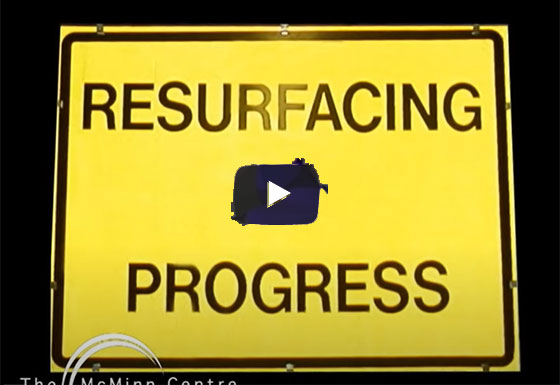Mini Incision Resurfacing Arthroplasty of the Hip (MIRAH) By Professor Derek McMinn

Derek McMinn performs a Mini Incision Resurfacing Arthroplasty of the Hip (MIRAH) Birmingham Hip Resurfacing (BHR) procedure, broadcast live via satellite to the United States.
Introduced by Orthopaedic surgeon Dr Lawrence Dorr MD, Derek McMinn MD FRCS performs a Birmingham Hip Resurfacing (BHR) procedure which was broadcast live via satellite to the United States in 2004.
Mr McMinn talks through each stage of the operation on the male patient's left hip in detail, from initial incision through to closing the wound. The surgical incision approach used by Mr McMinn was developed by Dr Todd Swanson MD in Nevada. For resurfacing, the incision has to be distally extended to allow exposure of the lesser trochanter. The amount of extension depends on the size of the patient and the amount of fat present.
In order to access the femoral head and acetabulum, Mr McMinn carefully cuts through the gluteus maximus muscle, making sure to coagulate vessels to prevent bleeding. Dislocation of the joint exposes the femoral head and acetabulum ready for the resurfacing process. The first assistant keeps moving the limb to make the femoral head more accessible for Mr McMinn to work on. It is important to remove all osteophyte at this stage because you want to know where the neck is, rather than neck plus osteophyte.
Measurements for the minimum and maximum femoral head and neck sizes are recorded for each patient. A template for each femoral component size is used to figure out which implant to use. In this patient, the implant size will be determined by the acetabulum size because there is plenty of substance in the femoral head to use either the 50 or the 54 component. The BHR sizing chart shows which component sizes are to be used with which cup size. It is colour co-ordinated and the femoral head component and acetabulum component colours must match.
The femoral head is then manoeuvred to prolapse beneath the abductor muscles to allow access to the acetabulum. The labrum cartilage is excised and osteophyte bone is removed from the acetabulum to prepare it for reaming. Mr McMinn starts with a 45mm acetabular reamer with the aim of reaching the true acetabular floor. The reamer size goes up in 2mm increments until there is resistance, indicating a final reamed size. The minor dysplasia that this patient had is not really a problem now as the acetabulum has been deepened and there is plenty of anterosuperior support, meaning that there will be no need for a dysplasia cup.
Once the cup is introduced and secured into place, the femoral head is manoeuvred back and the alignment tool is pinned into place to determine the correct insertion point for the component. A cannula attached to a tube and suction is placed into the canal of the femur. Once aligned, the cutter is used to remove the surface of the femoral head and the osteophyte is trimmed off to make it suitable for the component. A sleeve ring is placed around the cut femoral head and the top surface is removed, before it is chamfered into shape. Holes are drilled into the surface and cysts are removed in preparation for the cement.
Low viscosity cement is used with a mix to insertion time of one minute. When the component is being secured into place, a lot of fat and marrow is sucked through the vent, rather than being entered into circulation. The venting reduces incidence of fat embolization into the systemic circulation and this has been tested using transesophageal echocardiography. Filling the acetabular component with saline before moving the joint back into place makes sure that there is no soft tissue damage during the manoeuvre. Range of movement, stability and impingement checks are all carried out before the wound is carefully closed using sutures and skin clips.
| 

